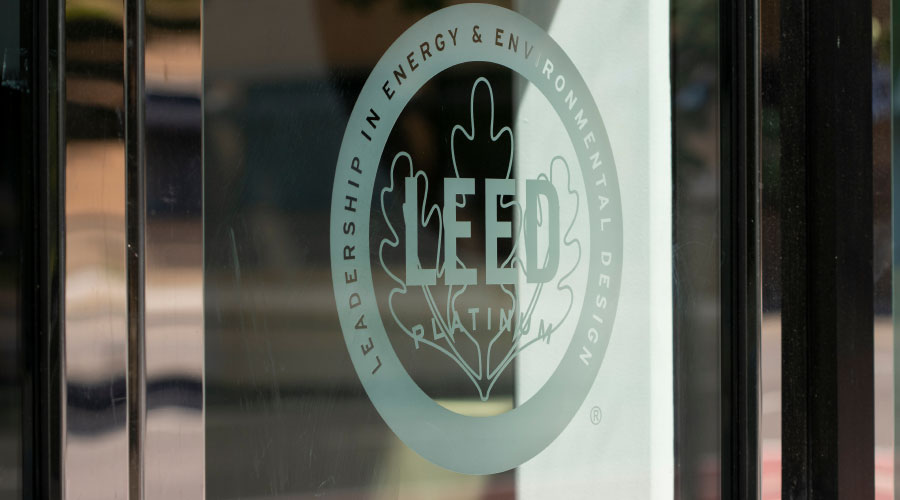LEED v4 Demand Response Pilot Credit Encourages Analysis Of Outside Power Generation
U.S. Green Building Council Perspective
USGBC Pushing Efficiency in Power Distribution with Demand Response
By Jacob Kriss, media associate, U.S. Green Building Council
Through the LEED green building rating system, building owners and operators are encouraged to think holistically about their projects and the impacts they have on associated systems outside of the building walls. The interconnectivity between energy-use decisions and the effects on outside power generation and capacity are among these important considerations. To maximize efficiency in electricity production and distribution and increase the reliability of the power grid, the U.S. Green Building Council (USGBC) launched the Demand Response Pilot Credit in July 2010. The credit will be a part of LEED v4 when it is released this year.
The credit rewards projects that participate in automated demand response, or voluntarily scaling back of their energy usage at times of peak demand or when wholesale energy costs are high. These programs have tremendous potential for enhancing efficiency in power distribution systems, particularly in urban and business areas with many commercial and industrial buildings. When temperatures rise or fall dramatically, such buildings with a peak demand load greater than 200 kilowatts can place great strain on the grid and adversely affect its stability.
There are many benefits of effective demand response programs. In addition to lowering demands on the power grid, they can help reduce buildings' environmental impact and greenhouse gas emissions, strengthen the relationships between facilities and electricity generators, and reduce dependency on fossil fuels. Buildings that participate in demand response can lower their electricity costs by securing lower rates and receiving incentive payments from utilities, and help to ensure their access to electrical supply even at times of high demand.
Automated demand response, facilitated through installed energy management control systems, can be particularly helpful in enhancing grid efficiency, allowing buildings to respond quickly to any rapid fluctuations in demand. Such systems may work to reduce the building's electrical activity or shift electrical use to time periods with less collective demand on the power grid.
To satisfy the Demand Response Pilot Credit, LEED projects must demonstrate their ability to shift energy consumption by 10 percent of peak load demand during peak events. Projects can earn a point toward LEED certification by participating in existing utility-sponsored demand response programs that meet the pilot credit guidelines. The Demand Response Pilot Credit is available for pilot testing in LEED projects types working under the New Construction, Core & Shell, Schools, Retail, Healthcare and Existing Buildings: Operations & Maintenance rating systems. In LEED v4, the newest update to the LEED program, this pilot credit will graduate to become part of the rating system language.
Demand Response Partnership Program
To broaden participation in and knowledge of demand response, USGBC and the Environmental Defense Fund (EDF) have launched the Demand Response Partnership Program. USGBC and EDF partner with utility hosts and technology and solution providers to engage the building and energy communities to determine how to achieve common goals for sustainability and reliable electrical supply.
This program is focused on both developing the demand response market and conducting relevant research to measure and verify the economic and environmental benefits of demand response. Such research will help to enhance the LEED demand response credit language, develop understanding of the impact of demand response on grid reliability and advance peak demand and demand response benchmarking.
Southern California Edison (SCE) is the official utility host sponsor for this program. As one of the largest electric utilities in the state, SCE has experience developing residential and commercial demand response programs, and has been working with USGBC and EDF to explore the viability of demand response as a broad-scale energy management and grid stability strategy. In early March, USGBC and SCE began conducting outreach to LEED-certified projects in Southern California to solicit their participation in the program.
To learn more about demand response, the pilot credit and the Demand Response Partnership Program, visit USGBC.org/demandresponse.
GREEN BUILDING REPORT
BRIEFINGS
BACnet Changes
Changes to the BACnet standard will encourage smart lighting controls and other building automation controls systems, according to ASHRAE.
The new version of ANSI/ASHRAE Standard 135-2012, BACnet — A Data Communication Protocol for Building Automation and Control Networks will improve interoperability between lighting control products and other building automation systems providing more opportunities for energy savings, according to Carl Neilson, chair of the Standard 135 committee.
An addendum provides significant improvements to the alarm handling in BACnet including: improved fault handling, temporary alarm recipient subscriptions, improvements in scalability of alarm distribution and simplifications in alarm distribution to support less complex products.
For more information,
visit www.ashrae.org.
Embedding Green
The World Resources Institute recently released a report titled "Aligning Profit and Environmental Sustainability: Stories from Industry" which offers four ways companies can embed sustainability into long-term business strategy. They are:
1. Set goals that integrate environmental considerations into core business decision-making.
2. Implement internal mechanisms that ensure environmental sustainability is valued.
3. Vest the chief sustainability officer with greater authority over capital budget decisions and engage the sustainability team early in project planning.
4. Establish and manage metrics that comprehensively indicate risks and opportunities across the corporate value chain.
To read the full report, visit: http://bit.ly/WRIReport
U.S. Green Building Council
2101 L Street, NW, Suite 500
Washington, DC 20037
1-800-795-1747
Web site: www.usgbc.org
E-mail: info@usgbc.org
CHAIR
Allan Skodowski
Transwestern
CHAIR-ELECT
George Bandy
Interface
IMMEDIATE PAST CHAIR
Elizabeth J. Heiuder
Skanska
SECRETARY
Elizabeth Whalen
CalAg LLC
TREASURER
Lisa Shpritz
Bank of America
FOUNDING CHAIRMAN
S. Richard Fedrizzi |
Related Topics:














